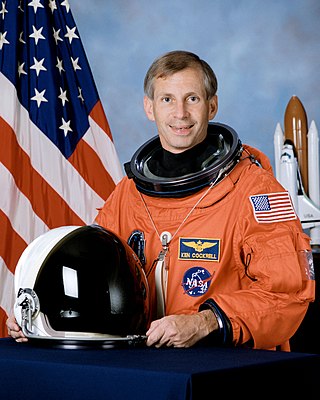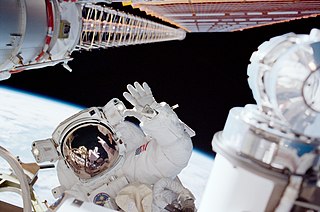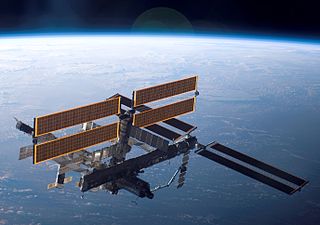
Kenneth Dwane "Sox" Bowersox is a United States Navy officer, and a former NASA astronaut. He is a veteran of five Space Shuttle launches and an extended stay aboard the International Space Station. When he launched on STS-73 at the age of 38 years and 11 months, he became the youngest person to command a Space Shuttle.

Kenneth Dale "Taco" Cockrell is a retired American astronaut, engineer and a veteran of five Space Shuttle missions. He served as Chief of the Astronaut Office from 1997 to 1998.

STS-30 was the 29th NASA Space Shuttle mission and the fourth mission for Space Shuttle Atlantis. It was the fourth shuttle launch since the Challenger disaster and the first shuttle mission since the disaster to have a female astronaut on board. The mission launched from Kennedy Space Center, Florida, on May 4, 1989, and landed four days later on May 8, 1989. During the mission, Atlantis deployed the Venus-bound Magellan probe into orbit.

Curtis Lee "Curt" Brown Jr. is a former NASA astronaut and retired United States Air Force colonel.

STS-72 was a Space Shuttle Endeavour mission to capture and return to Earth a Japanese microgravity research spacecraft known as Space Flyer Unit (SFU). The mission launched from Kennedy Space Center, Florida on 11 January 1996.

STS-76 was NASA's 76th Space Shuttle mission, and the 16th mission for Atlantis. STS-76 launched on 22 March 1996 at 08:13:04 UTC from Kennedy Space Center, launch pad 39B. STS-76 lasted over 9 days, traveled about 6,100,000 km (3,800,000 mi) while orbiting Earth an estimated 145 times, and landing at 13:28:57 UTC on 31 March 1996 at Edwards Air Force Base, runway 22.

Robert Lee "Hoot" Gibson, , is a former American naval officer and aviator, test pilot, and aeronautical engineer. A retired NASA astronaut, he also served as Chief of the Astronaut Office from 1992 to 1994. Today Gibson is active as a professional pilot, racing regularly at the annual Reno Air Races. He was inducted into the U.S. Astronaut Hall of Fame in 2003 and the National Aviation Hall of Fame in 2013, and has received several military decorations throughout his career.

STS-97 was a Space Shuttle mission to the International Space Station (ISS) flown by Space Shuttle Endeavour. The crew installed the first set of solar arrays to the ISS, prepared a docking port for arrival of the Destiny Laboratory Module, and delivered supplies for the station's crew. It was the last human spaceflight of the 20th century.

John Elmer Blaha is a retired United States Air Force colonel and a former NASA astronaut. He is a veteran of five space missions aboard the Space Shuttle and Mir.

Linda Maxine Godwin is an American scientist and retired NASA astronaut. Godwin joined NASA in 1980 and became an astronaut in July 1986. She retired in 2010. During her career, Godwin completed four space flights and logged over 38 days in space. Godwin also served as the assistant to the director for exploration, Flight Crew Operations Directorate at the Johnson Space Center. Since retiring from NASA, she accepted the position of professor in the Department of Physics and Astronomy at the University of Missouri.

Bruce Edward Melnick is a retired American astronaut and United States Coast Guard officer. Following retirement from NASA and the Coast Guard, he entered the aerospace industry. He served as a vice president with the Boeing Co.'s Integrated Defense Systems group, in charge of Boeing's Florida operations at the John F. Kennedy Space Center (KSC). Melnick retired in 2008 and currently resides on Merritt Island, Florida.

Mary Ellen Weber is an American executive, scientist, aviator, and a former NASA astronaut.

STS-115 was a Space Shuttle mission to the International Space Station (ISS) flown by Space ShuttleAtlantis. It was the first assembly mission to the ISS after the Columbia disaster, following the two successful Return to Flight missions, STS-114 and STS-121. STS-115 launched from LC-39B at the Kennedy Space Center on September 9, 2006, at 11:14:55 EDT.

STS-116 was a Space Shuttle mission to the International Space Station (ISS) flown by Space Shuttle Discovery. Discovery lifted off on December 9, 2006, at 20:47:35 EST. A previous launch attempt on December 7 had been canceled due to cloud cover. It was the first night launch of a Space Shuttle since STS-113 in November 2002.

STS-117 was a Space Shuttle mission flown by Space Shuttle Atlantis, launched from pad 39A of the Kennedy Space Center on June 8, 2007. Atlantis lifted off from the launch pad at 19:38 EDT. Damage from a hail storm on February 26, 2007, had previously caused the launch to be postponed from an originally-planned launch date of March 15, 2007. The launch of STS-117 marked the 250th orbital human spaceflight.
Space Shuttle missions designated STS-3xx were rescue missions which would have been mounted to rescue the crew of a Space Shuttle if their vehicle was damaged and deemed unable to make a successful reentry. Such a mission would have been flown if Mission Control determined that the heat shielding tiles and reinforced carbon-carbon panels of a currently flying orbiter were damaged beyond the repair capabilities of the available on-orbit repair methods. These missions were also referred to as Launch on Demand (LOD) and Contingency Shuttle Crew Support. The program was initiated following loss of Space Shuttle Columbia in 2003. No mission of this type was launched during the Space Shuttle program.

STS-126 was the one hundred and twenty-fourth NASA Space Shuttle mission, and twenty-second orbital flight of the Space Shuttle Endeavour (OV-105) to the International Space Station (ISS). The purpose of the mission, referred to as ULF2 by the ISS program, was to deliver equipment and supplies to the station, to service the Solar Alpha Rotary Joints (SARJ), and repair the problem in the starboard SARJ that had limited its use since STS-120. STS-126 launched on 15 November 2008 at 00:55:39 UTC from Launch Pad 39A (LC-39A) at NASA's Kennedy Space Center (KSC) with no delays or issues. Endeavour successfully docked with the station on 16 November 2008. After spending 15 days, 20 hours, 30 minutes, and 30 seconds docked to the station, during which the crew performed four spacewalks, and transferred cargo, the orbiter undocked on 28 November 2008. Due to poor weather at Kennedy Space Center, Endeavour landed at Edwards Air Force Base on 30 November 2008 at 21:25:09 UTC.

STS-132 was a NASA Space Shuttle mission, during which Space Shuttle Atlantis docked with the International Space Station on May 16, 2010. STS-132 was launched from the Kennedy Space Center on May 14, 2010. The primary payload was the Russian Rassvet Mini-Research Module, along with an Integrated Cargo Carrier-Vertical Light Deployable (ICC-VLD). Atlantis landed at the Kennedy Space Center on May 26, 2010.

NASA Astronaut Group 16 was a group of 44 astronauts announced by NASA on May 1, 1996. The class was nicknamed "The Sardines" for being such a large class, humorously implying that their training sessions would be as tightly packed as sardines in a can. These 44 candidates compose the largest astronaut class to date. NASA selected so many candidates in preparation for the anticipated need for ISS crew members, along with regular shuttle needs. Nine of the 44 astronauts selected were from other countries including 5 from Europe and 2 from Canada and Japan.

STS-135 was the 135th and final mission of the American Space Shuttle program. It used the orbiter Atlantis and hardware originally processed for the STS-335 contingency mission, which was not flown. STS-135 launched on July 8, 2011, and landed on July 21, 2011, following a one-day mission extension. The four-person crew was the smallest of any shuttle mission since STS-6 in April 1983. The mission's primary cargo was the Multi-Purpose Logistics Module (MPLM) Raffaello and a Lightweight Multi-Purpose Carrier (LMC), which were delivered to the International Space Station (ISS). The flight of Raffaello marked the only time that Atlantis carried an MPLM.




















